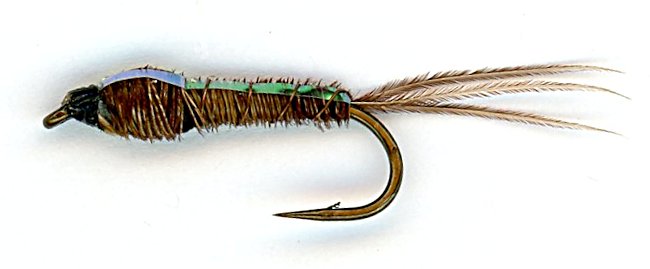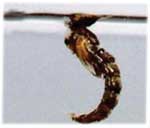The Flashback Pheasant Tail Nymph Fly
The English Fly fishing Shop carries a range of six Pheasant Tail Nymphs. Some have flash on the top of their body but the flashback pheasant tail nymph has it on top of the whole length of the nymph. The flash helps catch the eye of passing trout. The aim is to suggest the sparkle seen in the water caused by the gases trapped within the skin of a mature rising nymph as it prepares to hatch into a mayfly dun.

PHEASANT TAIL FLY PATTERNS. Hook size 12 14 16 18 - $US each
Using Pheasant Tail Nymphs Flies For Winter Fly Fishing
There is normally no need to hurry to be on the water before noon in winter and you will be finished by dusk. The best winter fishing is during the warmest part of the day. Trout food is not as scarce as you think at this time of the year. You might not see any insect activity on the water surface but there is lots of activity on the bottom as they prepare for the coming season of hatches. A trout’s metabolism slows in the cold water but it still needs to eat to survive. They may not eat as much as in the summer but they still search out food. Nymph fishing is the best method for this time of the year. Lightning Bug, Copper John, Beaded Gold Ribbed Hare’s Ear Nymphs and Pheasant Tail Nymphs fished dead drift in the current can be very productive. Make sure you work the water thoroughly as cold winter trout will not move a great distance to take a fly. I concentrate on deeper runs, pools and shallow water. I fish slow and deep on a floating line with a strike detector. Takes can be subtle so you have to concentrate hard.

Pheasant Tail Nymphs as Point Flies
Many trout flyfishing anglers on Stillwater loch, lake and reservoirs use a rig of three flies on a cast. Each fly used has a specific job to do. What do I mean by that. I will start at the top. This fly is normally a palmered fly or another buoyant fly. The main desirable characteristic of this fly is for it to it to be visible and cause a little wake and bounce across the ripple. They can catch surface feeding trout but also act as an indicator for takes on the flies below the water. The point fly is usually streamlined and heavier than the middle flies. The hook size is larger. It provides a subtle anchoring effect on the whole cast. I like to use a hook size 12 or 10 Pheasant Tail Nymph as my point fly. The middle flies tied on to the main leader as droppers can vary to match the conditions and the local insect population.
The Speckled winged Quill Mayfly
In some areas of North America the Speckled Winged Quill mayfly (callibaetis) can be the dominant mayfly found in lakes. It is important for fly fisherman as it hatches from April to the end of September depending on the location of the lake. Mayfly eggs grow to maturity in about six weeks if the water temperature is warm enough. It is a good hatch to match for those fly fishermen that do not like getting up too early in the morning or staying out late in the evening and missing out on valuable time at the bar. Most hatches occur mid-morning to early afternoon. I use an Adams dry fly pattern on a hook size 14 on a floating line dead drift over the feeding trout.
A pheasant tail nymph is a good imitation to use as part of a team of two or three flies. Trout will turn their attention to the duns when they see them floating on the surface waiting for their wings to gain enough strength to allow them to fly off. But these fish will be feeding on the rising nymphs a few hours before the onset of the hatch. Some will continue to take them during the hatch and afterwards. I have found that a flashback pheasant tail nymph will out fish a plain pheasant tail nymph by about three to one. The Speckled Winged Quill mayfly nymph is a swimmer rather than a crawler or clinger. I try to fish a flashback pheasant tail nymph as a point fly a few inches above the lake bottom.
Check list for chalk stream clear water fly fishing
One of the great things about fishing chalk streams compared with still-water loch, lake and reservoir fishing is that you can normally see your target trout. You will be able to see the trout turn their nose up if they refuse your fly. If you think your presentation was correct then then change you’re your fly and try again. You are able to get great feedback from your prey if you observe their reaction to each new tactic you deploy. You cannot do that in Stillwater. It is easier for a loch, lake and reservoir fisherman to switch to clear water river and stream fishing than the other way around but they have to remember that due to the increased visibility a lighter touch is needed to succeed in securing more trout and grayling hook ups.
Your eyes are the most important piece of equipment you bring with you, not anything you buy at a flyfishing tackle shop. You also have to use your brain. The trout have eyes and other senses that help them avoid larger predators and avoid clumsy anglers. One fast move, a misplaced footstep, standing in an upright position on a bank when a crouched approach might have been wiser will cause trout to dash for cover.
I like to use an 8ft rod. Some people prefer shorter rods but I find when most of your line is off the water hooking is easier. You are better connected to the fly. Go light when fishing chalk streams. Anything you cannot put in your coat pockets or attach to your jacket with a strap then leave at home. Always take your Polaroid glasses so you can see through the glare. They also protect your eyes from the danger of hooks.
Walk slow. The faster you walk along a bank the less you will see. Stop in one spot and study the water. The longer you stay the more you will see. Forget the idea of continuous casting to cover the water hunting for feeding fish. On clear chalk streams you use your eyes to locate trout and grayling. You then cast to them. What are you looking for? Don’t expect to see the classic circular ripples on the surface caused by a rise. You have to train your eyes to look for changes in light on the water surface. The smallest dimple or the most insignificant flicker on the surface is an indicator that there may be fish patrolling in that location for aquatic nymphs. On sunny days I look for moving shadows on the river or stream bed cast by trout as they are easier to detect than the camouflage animals.
A lake or other large water trout has to go hunting for its food. A chalk-stream fish just finds a good position where he can wait and pounce on any good morsel that drifts past his nose. This is the trout’s “lie”. They tend to stay in the same area. They do move if disturbed or to grab some food. You will see them move an inch here and an inch there to get into a better spot. If a larger fish arrives in the same weed clump or a shadow of a heron flies over head they shift location. It is then that you might be able to detect there location.

